Is Flying Or Driving Safer? Yes, flying is generally safer than driving, especially when considering commercial airlines. However, general aviation (GA) flights, including private planes, have a higher accident rate than driving. Let’s delve into the accident statistics, risk factors, and safety measures to help you make informed decisions about your travels and explore aviation safety with flyermedia.net.
1. Is General Aviation Flying More Dangerous Than Driving?
Yes, general aviation (GA) flying is more dangerous than driving, with personal GA flights being significantly riskier. While airline travel boasts an impressive safety record, personal GA flights have a fatal accident rate over 27 times higher than driving.
To accurately compare the safety of driving and flying, it’s crucial to understand how accident rates are reported. The National Highway Traffic Safety Administration (NHTSA) measures accidents per 100 million vehicle miles traveled, while the National Transportation Safety Board (NTSB) uses accidents per 100,000 flight hours. To establish a common metric, a 2020 study revealed that fatal car crashes occur at a rate of 0.6 to 0.7 per million hours driven. In contrast, the NTSB reported 9.5 fatal GA crashes per million flight hours in 2021. This data illustrates that overall GA flying is approximately 14 times riskier than driving. However, it’s important to note that personal flights account for a substantial portion of GA accidents and fatalities, with a rate of 21.1 fatal accidents per million flight hours between 2012 and 2021. This is even more dangerous than riding a motorcycle.
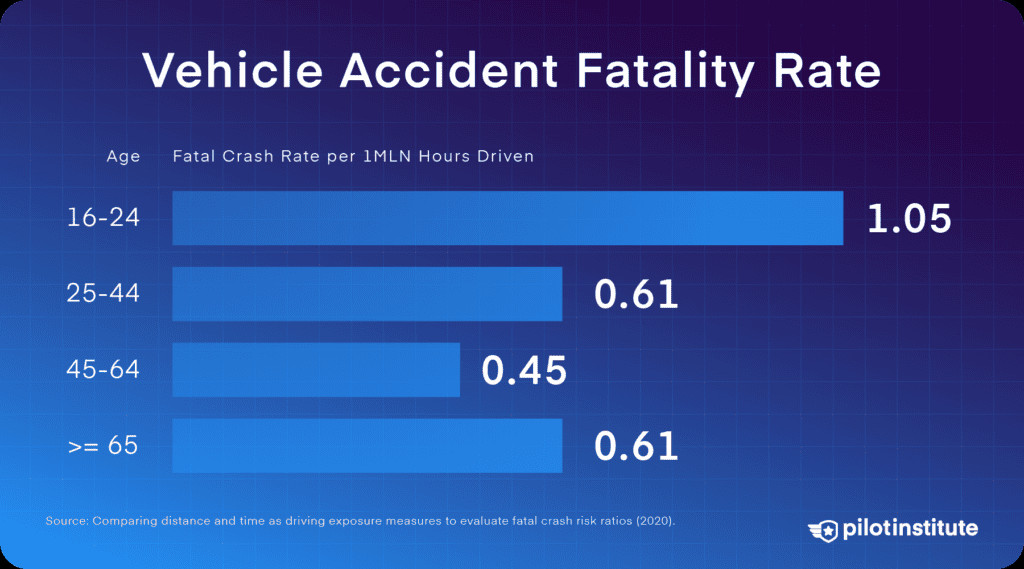 Vehicle accident fatality rate by age
Vehicle accident fatality rate by age
2. What Factors Contribute To The Higher Risk In General Aviation?
Pilot error, mechanical failures, and other/unknown causes all contribute to the higher risk in general aviation. Pilot error is the leading cause of GA accidents, accounting for 69% of all incidents, with loss of control in-flight being the most common and fatal defining event.
2.1. Pilot-Related Causes
Pilot-related factors are the primary contributors to GA accidents. According to the AOPA’s Richard G. McSpadden Report, human factors remain the leading cause of accidents despite efforts to teach pilots effective risk management techniques. In 2021, the pilot was deemed at fault in 69% of all GA accidents, highlighting the critical role of pilot proficiency and decision-making in ensuring flight safety.
Loss of control in-flight (LOC-I) is the most common cause of accidents and the most fatal.
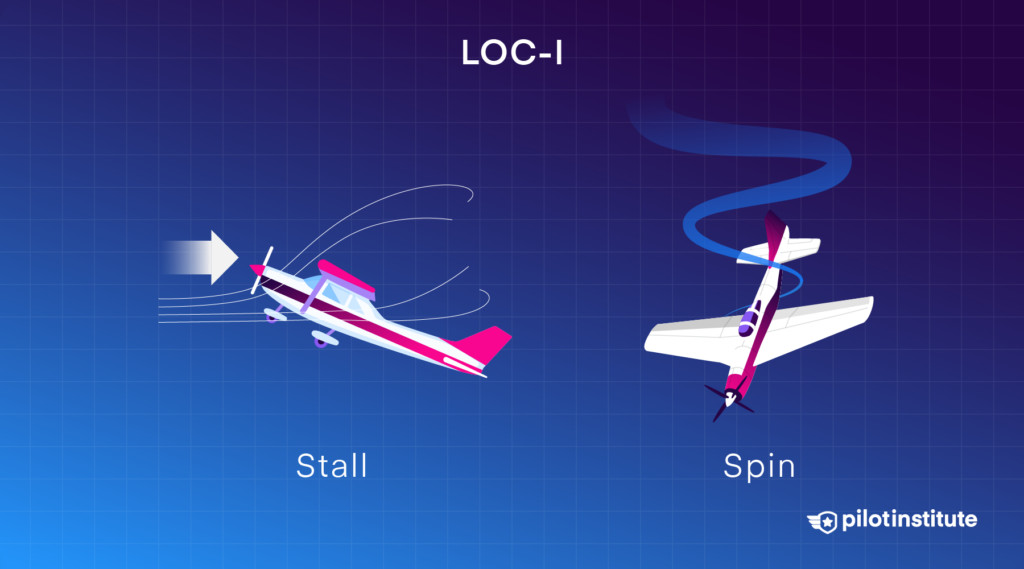 Loss of Control In-Flight: the leading cause of fatal accidents
Loss of Control In-Flight: the leading cause of fatal accidents
2.2. Mechanical Causes
Mechanical failures are the second most common cause of GA accidents, comprising about 16% of all accidents but only 7% of fatal ones in 2021. While engine failures are a significant concern, they are often manageable emergencies. AOPA found that 30% of engine failures don’t have a clear cause, while maintenance issues are behind 16%, and structural failures 17%. Common, preventable problems like carb ice or fuel issues account for the rest.
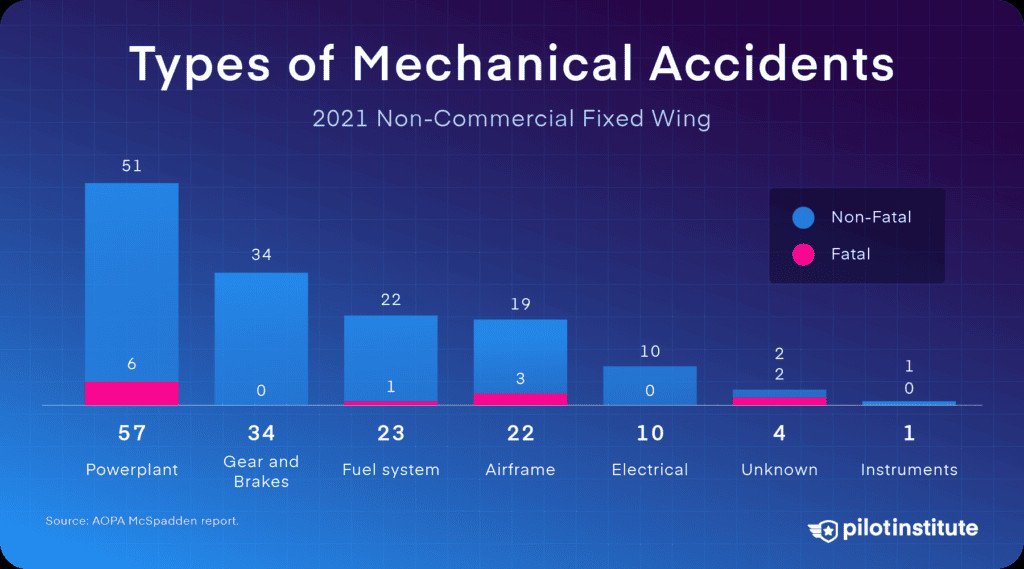 Types of GA mechanical accidents
Types of GA mechanical accidents
2.3. Other/Unknown Causes
In 2021, 15% of all accidents and 28% of fatal ones didn’t have a clear cause. These accidents are frustrating because without knowing why they happened, we can’t learn from them.
3. How Safe Are Instructional Flights Compared To Personal Flights?
Instructional flights are significantly safer than personal flights due to structured environments, supervised operations, and higher pilot proficiency. Instructional flights saw 2.3 fatal accidents per million flight hours, down 52% since 2012. That means flight training is only 3.4 times more dangerous than driving.
The reasons for the higher safety of instructional flights include:
- Supervised environment
- Structured operations
- High maintenance standards
- Proficient instructors
These factors contribute to a safer learning environment for aspiring pilots.
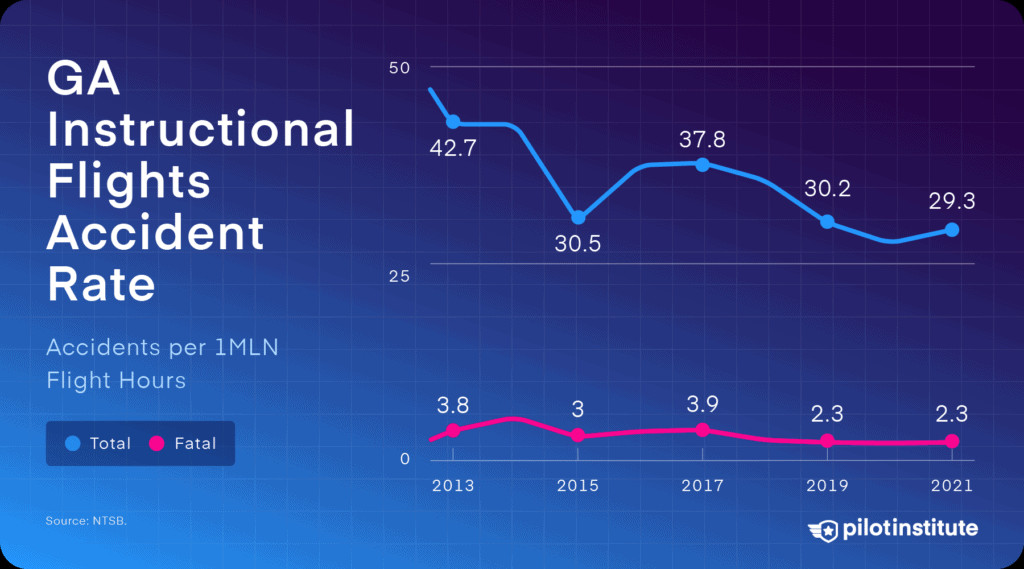 GA instructional flights accident rate: 2012-2021
GA instructional flights accident rate: 2012-2021
4. What Are The Most Common Types Of Accidents In General Aviation?
The most common types of accidents in general aviation include loss of control in-flight (LOC-I), landing accidents, and takeoff and climb accidents. Each of these accident types has unique risk factors and requires specific safety measures to mitigate.
4.1. Loss Of Control In-Flight
Loss of control in-flight (LOC-I) is the most common cause of accidents and the most fatal. This typically means the pilot lost control of the airplane due to factors such as flying too slow or making uncoordinated and abrupt control inputs.
4.2. Landing Accidents
Many GA accidents happen during landing, but they are not typically the most fatal. The most common landing accident is loss of control.
4.3. Takeoff And Climb Accidents
Takeoff and climb accidents have a higher fatality rate. The airplane is in a low-energy, low-altitude state with a high angle of attack, leaving little room for error in an emergency. While stalls may not be so fatal during landing, they’re the deadliest cause of takeoff and climb accidents.
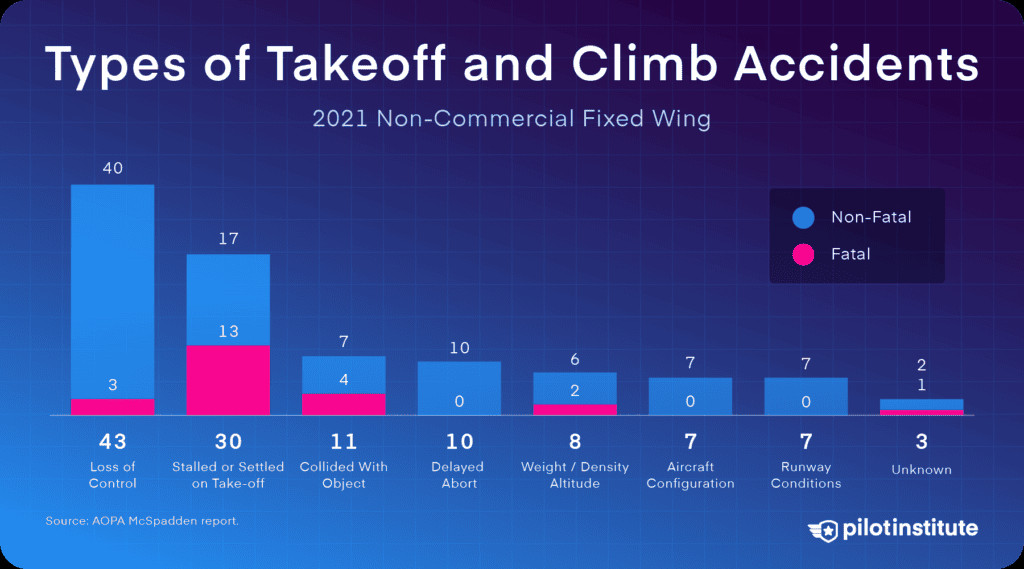 Types of GA takeoff and climb accidents
Types of GA takeoff and climb accidents
5. How Does Weather Impact The Safety Of General Aviation Flights?
Weather significantly impacts the safety of general aviation flights, with unintended VFR flight into instrument meteorological conditions (IMC) being a particularly dangerous scenario. Accidents caused by flying visually into clouds or low visibility had a 71% fatality rate in 2021. Poor IFR technique and icing were also deadly in 2021.
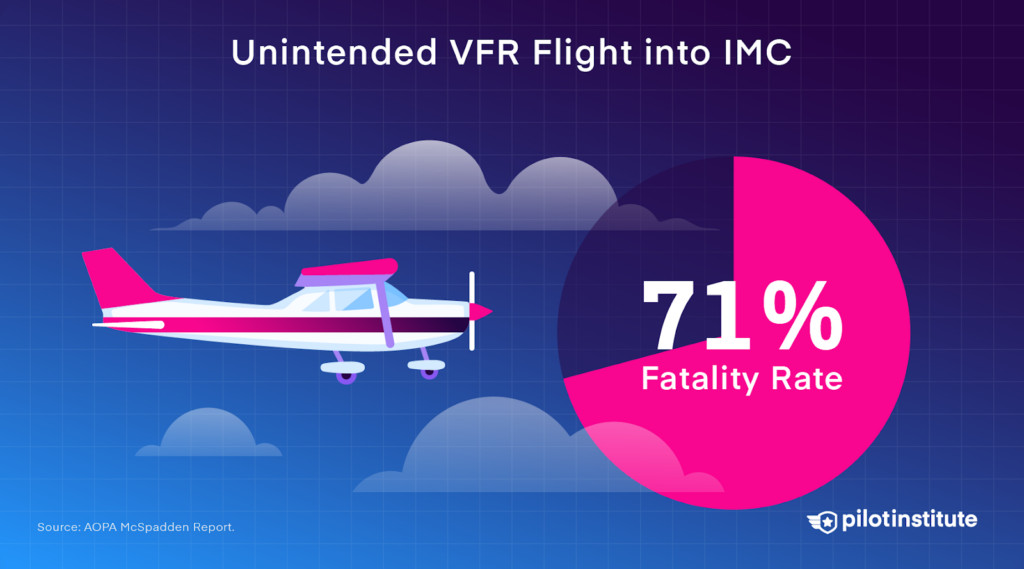 Unintended VFR flight into IMC has a 71% fatality rate
Unintended VFR flight into IMC has a 71% fatality rate
6. What Is Controlled Flight Into Terrain (CFIT) And How Can It Be Prevented?
Controlled Flight Into Terrain (CFIT) is an unintended collision with the ground or obstacle and is frequently a result of a total loss of situational awareness or attempts to “push” below minimums during instrument procedures. CFIT can be prevented by maintaining situational awareness, adhering to minimum altitudes, and using terrain awareness systems.
7. What Safety Measures And Best Practices Can Reduce Risk In General Aviation?
Several safety measures and best practices can significantly reduce risk in general aviation. These include maintaining pilot proficiency, adhering to structured operations, ensuring high maintenance standards, and adopting a safety mindset.
7.1. Pilot Proficiency
Proficiency requires going above and beyond the legal minimums. This includes regular training, simulator sessions, and staying current with the latest safety recommendations.
7.2. Structured Operations
Flight schools and airlines have structured operations that minimize risk-taking. GA pilots can adopt a similar approach by following checklists, adhering to standard operating procedures, and avoiding unnecessary risks.
7.3. High Maintenance Standards
Regular maintenance and inspections are crucial for ensuring the safety of GA aircraft. Unlike personal airplanes, instructional airplanes must undergo an inspection every 100 hours.
7.4. Safety Mindset
Adopting a safety mindset involves being disciplined, making wise decisions, and continuously assessing and mitigating risks. This includes being aware of personal limitations and avoiding situations that exceed one’s capabilities.
8. What Role Does Risk Management Play In Ensuring Aviation Safety?
Risk management plays a crucial role in ensuring aviation safety by identifying, assessing, and mitigating potential hazards. The FAA provides a risk assessment matrix to help pilots evaluate and manage risks associated with their flights. This matrix considers factors such as the probability and severity of potential hazards to determine the overall risk level.
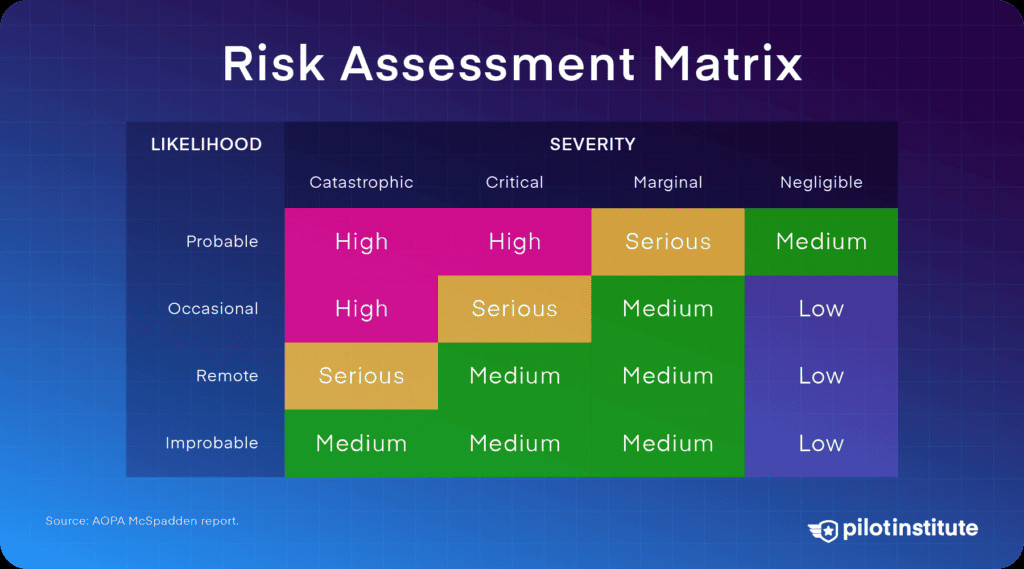 FAA Risk Assessment Matrix
FAA Risk Assessment Matrix
9. How Can Pilots Prevent Fuel-Related Accidents?
Pilots can prevent fuel-related accidents by taking several precautions, including checking the fuel for contamination, ensuring fuel is getting to the engine, and carefully planning flights to avoid fuel exhaustion. Fuel contamination can be prevented by checking the fuel before each flight. Fuel starvation can be avoided by selecting the correct fuel tank and ensuring the fuel selector is in the ON position. Fuel exhaustion can be prevented by carefully planning flights and monitoring fuel consumption.
 Types of GA fuel management accidents
Types of GA fuel management accidents
10. What Resources Are Available For Pilots To Improve Their Safety And Proficiency?
Pilots have access to a variety of resources to improve their safety and proficiency. These include the FAA Safety Team (FAASTeam), the AOPA Air Safety Institute, and various online courses and training programs. These resources provide valuable information, training, and tools to help pilots enhance their skills and knowledge.
10.1. FAA Safety Team (FAASTeam)
The FAA Safety Team (FAASTeam) offers a variety of safety programs, seminars, and online courses to help pilots improve their knowledge and skills.
10.2. AOPA Air Safety Institute
The AOPA Air Safety Institute provides a wide range of safety resources, including accident analysis reports, online courses, and safety seminars.
10.3. Online Courses And Training Programs
Several online courses and training programs are available to help pilots improve their safety and proficiency. These programs cover a variety of topics, including risk management, weather flying, and emergency procedures.
11. Is Corporate Aviation As Safe As Commercial Aviation?
Corporate aviation is relatively safe, with a fatal accident rate of 0.48 per million flight hours from 2012 to 2021. While this is higher than commercial aviation, it is significantly lower than personal flights. Corporate aviation benefits from professional pilots, structured operations, and high maintenance standards.
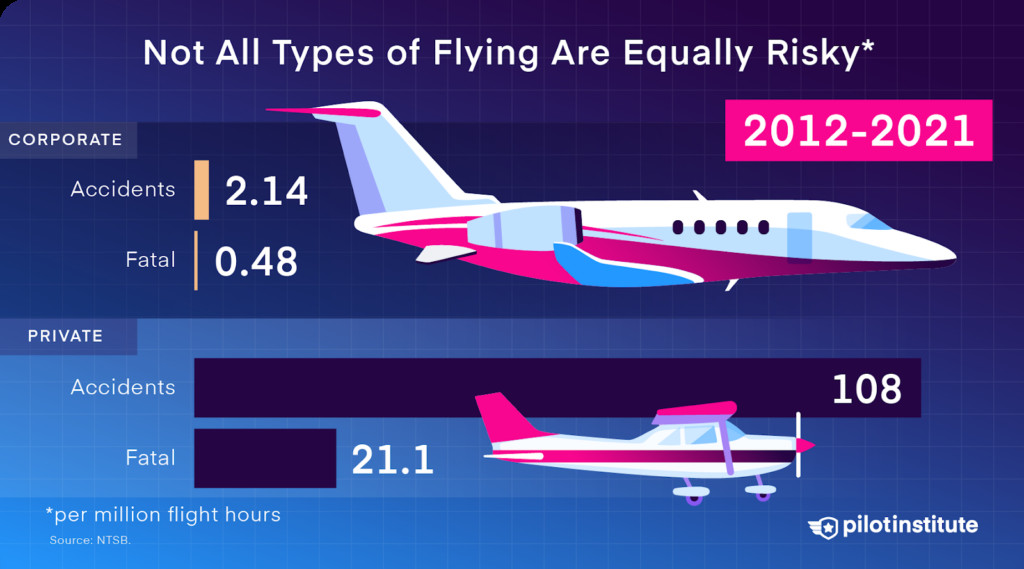 Corporate GA flying is quite safe compared to private flights
Corporate GA flying is quite safe compared to private flights
12. What Are The Key Differences Between Currency And Proficiency In Aviation?
Currency and proficiency are two distinct concepts in aviation safety. Currency refers to meeting the minimum legal requirements to fly, such as completing a flight review every 24 months and logging a certain number of takeoffs and landings. Proficiency, on the other hand, refers to having the skills, knowledge, and experience to safely operate an aircraft in a variety of conditions. While currency is a legal requirement, proficiency is a matter of personal responsibility and commitment to safety.
13. How Does The Design And Maintenance Of Aircraft Impact Safety?
The design and maintenance of aircraft have a significant impact on safety. Modern aircraft are designed with numerous safety features, such as redundant systems, advanced avionics, and crashworthy structures. Regular maintenance and inspections are essential for ensuring that these safety features are functioning properly and that the aircraft is safe to fly.
14. What Role Do Air Traffic Control (ATC) Play In Ensuring Aviation Safety?
Air Traffic Control (ATC) plays a critical role in ensuring aviation safety by providing guidance, separation, and information to pilots. ATC controllers monitor air traffic, issue instructions to pilots, and provide information about weather, traffic, and other potential hazards. By coordinating air traffic and providing timely information, ATC helps prevent collisions and ensures the safe and efficient flow of air traffic.
15. What Advancements In Technology Are Improving Aviation Safety?
Advancements in technology are continuously improving aviation safety. These advancements include:
- Advanced avionics: Modern avionics systems provide pilots with enhanced situational awareness, navigation, and decision-making capabilities.
- Terrain awareness systems: Terrain awareness systems provide pilots with alerts about potential collisions with terrain, helping to prevent CFIT accidents.
- Automatic Dependent Surveillance-Broadcast (ADS-B): ADS-B is a surveillance technology that allows aircraft to broadcast their position, altitude, and other information to ATC and other aircraft, improving situational awareness and reducing the risk of collisions.
- Enhanced weather radar: Enhanced weather radar systems provide pilots with more accurate and detailed information about weather conditions, helping them to avoid hazardous weather.
16. How Can Aviation Training Be Improved To Enhance Safety?
Aviation training can be improved to enhance safety by incorporating more realistic scenarios, emphasizing risk management, and providing pilots with more opportunities to practice emergency procedures. Realistic scenarios help pilots develop the skills and experience needed to handle real-world situations. Emphasizing risk management helps pilots make informed decisions and avoid unnecessary risks. Providing pilots with more opportunities to practice emergency procedures helps them develop the confidence and skills needed to respond effectively in an emergency.
17. What Regulations And Oversight Mechanisms Are In Place To Ensure Aviation Safety?
Aviation safety is regulated and overseen by various government agencies and international organizations. In the United States, the Federal Aviation Administration (FAA) is responsible for regulating and overseeing all aspects of civil aviation, including pilot training, aircraft maintenance, and air traffic control. The National Transportation Safety Board (NTSB) investigates aviation accidents and makes recommendations to improve safety. At the international level, the International Civil Aviation Organization (ICAO) sets standards and recommendations for aviation safety that are adopted by member states around the world.
18. How Does Human Factors Research Contribute To Aviation Safety?
Human factors research contributes to aviation safety by studying the interactions between humans and the aviation system. This research helps identify potential human errors and develop strategies to mitigate them. Human factors research covers a wide range of topics, including pilot workload, decision-making, communication, and fatigue. By understanding how human factors influence aviation safety, researchers can develop more effective training programs, procedures, and technologies.
19. What Are The Current Trends In Aviation Accident Rates?
While aviation accident rates have generally declined over the years, there are still areas of concern. According to the NTSB, the fatal accident rate for general aviation has remained relatively stable in recent years, while the accident rate for commercial aviation has continued to decline. This suggests that more needs to be done to improve safety in general aviation.
20. How Can Passengers Contribute To Aviation Safety?
Passengers can contribute to aviation safety by following the instructions of the crew, remaining seated with their seatbelts fastened during turbulence, and reporting any suspicious activity to the crew. Passengers can also help by being aware of their surroundings and being prepared for emergencies.
In conclusion, while flying is generally safer than driving, especially when considering commercial airlines, general aviation (GA) flights have a higher accident rate. By understanding the risk factors, implementing safety measures, and continuously improving training and technology, we can work towards making aviation even safer.
Visit flyermedia.net today to explore aviation safety in more detail, discover flight training programs, and stay up-to-date with the latest aviation news and trends. If you’re passionate about aviation and want to learn more, explore our website or contact us at Address: 600 S Clyde Morris Blvd, Daytona Beach, FL 32114, United States, Phone: +1 (386) 226-6000. Your journey into the world of aviation begins here!
FAQ: Is Flying Or Driving Safer?
1. Is flying safer than driving in general?
Yes, flying is generally safer than driving, especially when considering commercial airlines. However, general aviation (GA) flights, including private planes, have a higher accident rate than driving.
2. What is general aviation (GA)?
General aviation (GA) includes all aviation activities other than scheduled commercial airlines and military aviation. This includes private planes, flight training, corporate aviation, and other types of flying.
3. Why are commercial airlines safer than general aviation?
Commercial airlines have structured operations, highly trained pilots, and stringent maintenance standards. They also benefit from advanced technology and air traffic control systems.
4. What are the main causes of accidents in general aviation?
The main causes of accidents in general aviation include pilot error, mechanical failures, and weather-related factors.
5. How can pilots reduce the risk of accidents in general aviation?
Pilots can reduce the risk of accidents by maintaining proficiency, adhering to structured operations, ensuring high maintenance standards, and adopting a safety mindset.
6. What is loss of control in-flight (LOC-I)?
Loss of control in-flight (LOC-I) is a situation in which the pilot loses control of the aircraft due to factors such as flying too slow or making uncoordinated and abrupt control inputs.
7. What is controlled flight into terrain (CFIT)?
Controlled flight into terrain (CFIT) is an unintended collision with the ground or obstacle and is frequently a result of a total loss of situational awareness or attempts to “push” below minimums during instrument procedures.
8. How does weather impact the safety of general aviation flights?
Weather significantly impacts the safety of general aviation flights, with unintended VFR flight into instrument meteorological conditions (IMC) being a particularly dangerous scenario.
9. What resources are available for pilots to improve their safety and proficiency?
Pilots have access to a variety of resources to improve their safety and proficiency, including the FAA Safety Team (FAASTeam), the AOPA Air Safety Institute, and various online courses and training programs.
10. How can passengers contribute to aviation safety?
Passengers can contribute to aviation safety by following the instructions of the crew, remaining seated with their seatbelts fastened during turbulence, and reporting any suspicious activity to the crew.
